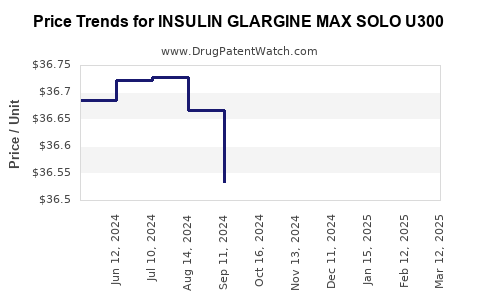Drug Price Trends for INSULIN GLARGINE MAX SOLO U300
✉ Email this page to a colleague

Average Pharmacy Cost for INSULIN GLARGINE MAX SOLO U300
| Drug Name | NDC | Price/Unit ($) | Unit | Date |
|---|---|---|---|---|
| INSULIN GLARGINE MAX SOLO U300 | 00955-2900-02 | 36.41650 | ML | 2024-11-20 |
| INSULIN GLARGINE MAX SOLO U300 | 00955-2900-02 | 36.48425 | ML | 2024-10-23 |
| INSULIN GLARGINE MAX SOLO U300 | 00955-2900-02 | 36.53375 | ML | 2024-09-18 |
| INSULIN GLARGINE MAX SOLO U300 | 00955-2900-02 | 36.66727 | ML | 2024-08-21 |
| INSULIN GLARGINE MAX SOLO U300 | 00955-2900-02 | 36.72698 | ML | 2024-07-17 |
| INSULIN GLARGINE MAX SOLO U300 | 00955-2900-02 | 36.72308 | ML | 2024-06-19 |
| >Drug Name | >NDC | >Price/Unit ($) | >Unit | >Date |


